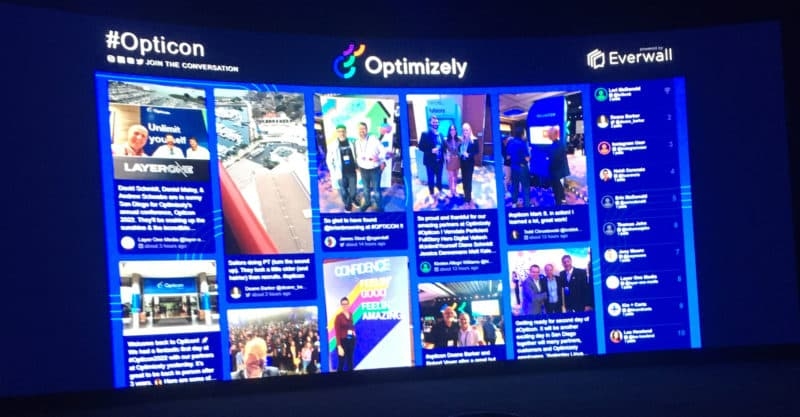Optimizely advocates for experimentation, collaboration and orchestration as it rethinks its DXP.

“The digital execution gap is wider than it’s ever been and gets wider every day,” Kirsten Allegri Williams, CMO of Opticon, told media and analysts at Opticon, Optimizely’s conference in San Diego this week.
The gap is between the experiences customers increasingly expect and demand from brands and the struggle most brands face in coming even close to fulfilling those needs. In his mainstage keynote, CEO Alex Atzberger categorized the main elements in the struggle as uncertainty, complexity and inertia.
Uncertainty is caused by a volatile environment in which every marketing plan can be buffeted by anything from a virus to climate change and from a disrupted supply chain to runaway inflation. Complexity refers to the far-from-linear customer journey created by the continuing explosion of channels and content types. Inertia? Largely caused by having too much data, little of it actionable.
The challenges are clear — how to address them, less so.
Marketing without limits
Optimizely’s approach can be seen as two-tiered. Top tier: proselytising for “Boundless Digital Invention” based on scientific insights derived from experimentation. Second tier: an environment in which teams can collaborate to achieve the top tier vision. Let’s break that down; but first a quick look at recent history.
Episerver, as most marketers know or knew it, grew out of the 2015 merger of Stockholm-based Episerver and New Hampshire-based Ektron to create a new commerce and CMS offering under the Episerver name. Even in 2015, Episerver was locating itself in the digital experience platform category.
Against the background of COVID, with many brands forced to raise their digital game, Episerver went on an acquisition spree, the most significant acquisition being that of Optimizely, an experimentation platform enabling rapid, multiple testing of digital design decisions and features — even enabling the testing of different options on different audience segments.
Episerver rebranded as Optimizely in 2021, and its web experimentation and feature experimentation (formerly known as Full Stack) capabilities have become increasingly central to the vendor’s vision.
In the case of Boundless Digital Invention, a culture of continual testing across multiple elements of digital strategy should boost confidence, reduce risk, and produce measurable — even if incremental — improvements in performance across important KPIs (increased conversions, reduced cart abandonments, more clicks, etc.
That culture of experimentation calls on teams to fail fast, learn on the fly, and constantly reiterate. But it does seem to call for the involvement of multiple teams and a degree of orchestration between their efforts.
Orchestrating the entire content lifecycle
That’s where the second tier comes in — a new Orchestrate solution announced at Opticon this week. This offering is based on another acquisition, that of Welcome, the collaboration and orchestration platform purpose-built for marketing teams, picked up by Optimizely in December, 2021.
Simply put, Optimizely is bringing together content marketing (Welcome), its long-established CMS, and its digital asset management tool, into one environment usable by business teams and not just developers. The dashboard will give visibility into the full lifecycle of projects and campaigns and allow collaborative creation of marketing content outside the CMS, reducing risks of CMS use by non-experts.
The environment can be used to plan, preview, publish and manage content across channels — and of course test different versions across selected audience segments. In mainstage demos, the offering was contrasted with approaches to collaborative content creation based around email chains, text messages, spreadsheets and phone calls — a contrast that audibly resonated with the audience.
But this collaboration, Atzberger emphasized, needs to reach beyond marketing and embrace product and engineering too (because some of the experimentation is likely to indicate changes that require developer skills). “We have to first establish that marketing is no longer alone,” he said.
The reality check
Optimizely executives were forthright in acknowledging that the perspective they are offering can’t be executed by the technology alone. There are crucial customer-side changes that are needed. For example:
The digital maturity curve
Many businesses, especially in some of the far-from-digital-first B2B verticals that had to rethink their commerce strategies under COVID, are simply not yet equipped for the unlimited digital invention envisaged here. A midmarket or large but digitally immature brand simply might not have the teams or talent to run continuous experimentation and execute on the results. A real world challenge for Optimizely, as it has explicitly pitched to traditional B2B businesses and not just established e-commerce brands.
Optimizely recognizes this. It’s about building a bridge, said CCO Chad Wolf: “How do we get them there?” Part of the answer lies in a consultative relationship before and after purchase, and Optimizely’s extensive eco-system of implementation partners has a role here too.
Full platform versus à la carte
The Orchestrate approach, and in general Optimizely’s holistic solution to uncertainty, complexity and inertia, seems to assume teams coming together on one digital experience hub (certainly, with some integrated point solutions too). And yet, like Episerver, it continues to allow customers to select and adopt individual products rather than the entire digital experience platform.
This is real world challenge number two for Optimizely, not least because the pre-acquisition Optimizely developed a strong portfolio of major enterprise clients who came to them for testing and experimentation, but not for a CMS or DAM. Chief Product Officer Justin Anovick conceded that this required “threading the needle.” On the one hand, it was essential to offer customers what they want and need; at the same time there was a belief in the value of the products in the platform all working together.
Organizational transformation
A third challenge confronts, not so much Optimizely, as some of their customers. If it is the case that marketers need to strategize and execute alongside other teams like product and engineering, it’s not the case that every client is ready to do that. There are many brands with siloed teams; many with no culture of cross-team collaboration.
That’s something Optimizely can’t fix by fiat. Again, consultation, including with implementation partners, can only suggest the most fruitful paths to follow.
The promise of simplicity
Ultimately, Optimizely is betting that the promise of simplicity — in data-driven decision making, in workflows, in exchanging guess-work for experimentation-based understanding — will compel brands towards the kind of solution offered here.
“The digital transformation era brought with it the promise of limitless innovation. But as more
technologies were adopted and data became overwhelmingly unstructured and siloed, it created the
opposite effect – forcing marketers to lower their expectations as they were pressured to deliver
outcomes within restricted workflows,” said Atzberger in a release. “The future of
marketing hinges on removing these limits.”
The post Marketing beyond boundaries at Opticon appeared first on MarTech.
(11)




